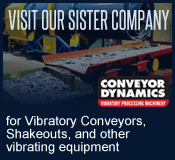

Hillside Aluminum Gets Safer, More Effective, & More Efficient
Hillside Aluminum, located in Richards Bay, South Africa is the first aluminum smelter to use a DIDION Rotary Separator to clean its fluorinated waste and carbon from cast iron before charging into the induction furnaces. This process recycles the cast iron for re-use in the pouring of a new thimble for use in the reduction of alumina. This rotary drum type system, widely used in the foundry industry, has been customized for the thimble cleaning application at Hillside. It replaces the capital intensive and high-maintenance system that has been the standard in primary production plants for this anode production process.
Previous to the installation of the DIDION rotary system, the cast iron thimbles from used anodes were first separated from the anodes by an automated process and then directed to a cleaning operation.
The old cast iron cleaning system at the Hillside smelter consisted of an impact crusher. The method was used to crush the cast iron before cleaning it with a barrel shot blaster. The impact crusher was a first for an aluminum smelter and probably the first for crushing cast iron. It was never tested for this application and did not prove successful in its five years of operations at Hillside. The installation also took up a great deal of room.
Plans to upgrade the system began in 1998, and several ideas were investigated. Material was sent to the DIDION manufacturing facility in St. Peters, Missouri, for testing with very promising results. In June 1999, a decision was made by the carbon production team at Hillside that the best equipment to clean the cast iron would be a DIDION. The decision was made after a full analysis of all of the options that were available. A project team comprised of maintenance, production, and engineering personnel was set up to spearhead the project. The main problems were the size of the Hillside thimbles and the size of old assembly pins. The idea was also to have a system that would allow use of the pins to produce cast iron.
After several conceptual designs, the idea of using a specially designed Rotary Separator, based upon what DIDION has supplied in the foundry industry, emerged as a viable option. This was a significant improvement in the operating expense of the previously used shot blasting system. The project installation took place in July 2000 over a 10-day shutdown period. The system was handed to production and has now been in operation since October 2000.
Hillside management indicated that this project is a success for the following reasons:
- Simple process design with less equipment and fewer moving parts
- Rotary tumbling action for better cleaning, even from difficult to clean pockets in the thimbles
- No carbon carry-over
- No replaceable shot
- Significant reduction of new make up cast iron by 50%
- Realization of further savings by introducing old pins into the cast iron system
Hillside has seen an added advantage in cast iron melting. With all the fluorinated waste removed, the introduction into the furnace is cleaner, there-by reducing furnace fumes and also increasing the life of the furnace lining.
The DIDION has a capacity of up to ten tons per hour, cast iron throughput with carbon at one ton per hour at a very low energy requirement. There are also several benefits from the equipment maintenance and operating parameters:
- Precision laser alignment of bearings for minimum wear
- Reduction of noise levels, and heat load on surroundings
- Reduced dust emissions due to containment in the drum
- Very low dust collection volume flow rates due to small open area
- Simple foundation requirements
- Fully automatic feed of thimbles
- Patented, segmented cast liners provide lower noise, better wear resistance, and ease of replacement.
The principle of operation for the DIDION is low velocity impacting of the cast iron feed material. This feed material is lifted by the rotation of the drum and consequently drops from lifters cast in the wear liners within the drum itself. This tumbling action causes the products to impact upon each other and releases the trapped fluorinated waste and adhered carbon along with any other friable attachments. The released material is allowed to pass through holes within the wear liners as it is fed backwards inside a plenum chamber. It is then air transported to the bag house for collection.
Once the cast products reach the end of the drum, they are automatically discharged and ready for remelting within the induction furnaces.
To learn how DIDION Rotary Processing Equipment can improve the way you do business, please contact us today.

